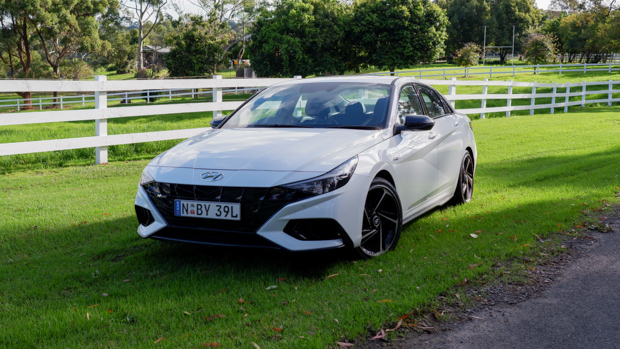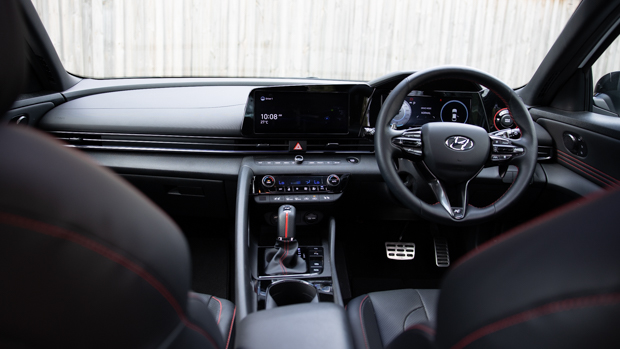-
Car Reviews
- All reviews
- Midsize SUVs
- Small cars
- Utes
- Small SUVs
- Large SUVs
- Large cars
- Sports SUVs
- Sports cars
- Vans
Latest reviews
- Car News
-
Car Comparisons
Latest comparisons
- Chasing Deals
The Hyundai i30 Sedan may share badges with its popular hatchback stablemate, but differences in usability and driving dynamics make the four-door an interesting standalone worth considering
The Hyundai i30 hatch represents a proud chapter in the Korean brand’s ascension into the big leagues. It’s played a large part in Hyundai now being voiced in the same breath as Toyota or Volkswagen with a stern nod of agreement rather than a chuckle of disrespect.
When Hyundai Australia ushered in the new-generation Elantra in 2020 it dropped the old name in favour of the rather descriptive ‘i30 Sedan’ moniker. But in doing so has this svelte sedan been robbed of its own identity?
While logical from a brand awareness standpoint, you have to feel for the average punter scratching their head trying to decide between the handy hatch and the striking sedan. Underneath the body work, you see, are two very different vehicles.

The i30 Sedan N Line represents a spicy take on the small car formula, though at 4675mm long the Hyundai isn’t far off large cars like the Toyota Camry.
Unlike the hatch, the i30 Sedan in top-spec N Line Premium guise (as tested here) is only offered with a seven-speed dual-clutch transmission. That means buyers miss out on a decent six-speed manual and the increased driver involvement that brings, and likely a lower price point.
At $38,190 before on-road costs, the i30 Sedan N Line Premium commands $5000 more than the ‘base’ auto-equipped N-Line model, though for the extra cash you net several luxuries, the most compelling being a sporty N Line-styled leather interior.
This brings heated and ventilated front seats (with power adjustment on the driver’s side), a sunroof, front parking sensors and an enhanced technology package featuring a 10.25-inch touchscreen – up from a rather petite 8.0-inch unit.
Having sharp lines, 18-inch wheels and a muscular body kit is all well and good but it’s all a bit embarrassing if you can’t back it up with solid performance. Thankfully, the i30 Sedan N Line has no problems cashing its cheques in this department.
Hyundai has fitted all of its N Line i30s – and the bratty i20 N hot hatch – with a 1.6-litre turbo-petrol four-cylinder engine. It produces 150kW at 6000rpm and 265Nm of torque between 1500 and 4500rpm in this configuration.
Considering this grunt only needs to motivate a kerb weight of 1340kg, it’s no surprise the N Line has some serious hustle once the needle enters its broad torque band; and despite the turbocharging, the engine has no trouble revving freely either.

Those who like shifting their own gears will be happy to know the seven-speed dual-clutch will obediently hand over control when asked, but in my experience, the automatic ’box was generally on the ball with snappy downshifts once popped into Sport mode.
Coasting along potholed Sydney roads has become an increasingly hostile exercise of late, but the i30 Sedan takes these types of conditions in its stride, despite its sportier suspension tune.
Opting for the N Line variant means the i30 Sedan trades its conventional torsion beam rear suspension for a more sophisticated multi-link arrangement that works in conjunction with the struts at the front to provide a generally comfortable ride with disciplined body control.

Sitting on the newly-developed K3 platform provides the i30 Sedan with a distinguishable advantage over the hatchback – it’s built on the older K2 chassis. In everyday driving the sedan feels more composed than the hatch and with an extra 70mm wheelbase (2720mm); the three-box i30 also feels more stable on the limit.
The bite from the driven front wheels is sharp, but not razor sharp like full-fat N models – and the exhaust soundtrack is also more polite, though this is one of many factors that makes the i30 Sedan N Line feel far more suited to daily driving duties.
Hyundai Australia made the controversial decision to skip ANCAP safety testing for the local introduction of the i30 Sedan, so officially the car remains unrated, but executives assured Chasing Cars at launch they were selling a safe car.

Over in the US, where the i30 Sedan is still known as the Elantra, the country’s local testing authority NHTSA awarded the Hyundai five stars – but differences in our local specification and ANCAP’s rules make a theoretical result hard to predict.
Australian-equipped models feature six airbags, though sadly this does not include a front row centre airbag like many cars in this segment.
The driver assistance package includes rear cross-traffic alert, adaptive cruise control (with stop and go) and blind-spot monitoring along with family-friendly features like safe-exit assist, rear-occupant alert plus forwards and reversing AEB.
In practice, I found this safety assistance technology worked as advertised, though the lane-keep assist is a bit too aggressive and the sensors were occasionally confused between the lane markings and haphazard road repair lines.
While the i30 hatch offers a welcoming and functional interior space, the sedan pushes the game forwards with a more modern and striking design.
Hyundai has fitted the i30 Sedan N Line with supportive N Line-branded seats offering a good balance of postural support and appropriate bolstering for performance driving, without being a hindrance when climbing in and out of the cockpit. The driver also benefits from power adjustment with lumbar support, though the passenger misses out on this convenience and is stuck with handles.
Both front occupants benefit from a good amount of room to stretch out, along with features such as seat heating and ventilation, and other premium pleasantries like a 10.25-inch digital instrument cluster, sunroof and a wireless phone charger.

Due to Hyundai’s seemingly never-ending tussle with one of the corporate tech giants, Apple CarPlay and Android Auto retain a wired connection to the adjoining 10.25-inch touchscreen.
Opting for the N Line Premium introduces an eight-speaker Bose stereo system, which is fine enough, though the sound lacks depth and the bass could be stronger.
While test cars are known to live very hard lives, I was disappointed to find the centre console of our particular i30 Sedan N Line (with 14,000km on the clock) exerted quite a lot of movement and a corresponding creak when a knee was leant up against it, or the adjoining grab handle was used.

The quality of materials inside the cabin is hit or miss; with Hyundai using a mixture of soft plastics on the door tops and harder materials in other high-traffic areas. The lack of armrest padding on the window side armrests in both the front and rear is disappointing.
The additional length of the sedan over the hatch has granted rear occupants fantastic legroom matched with supportive seating and dedicated air vents. The back seats happily accommodate six-foot-tall adults like myself for extended periods, though they might do so with a flat phone battery as there are no USB ports – just a regular old 12-volt socket.
Family buyers will appreciate child seat top-tether hooks conveniently located just behind rear headrests. This saves any undignified faffing about in the boot, and the sensible ride height won’t make strapping in a little one too difficult on your back.

Buyers cross-shopping the N Line with the full-fat i30 Sedan N should also consider the N Line features 60-40 split-fold rear seats, while the latter has only a single folding bench.
Behind the rear seats is a sizeable 474-litre boot, offering a good chunk more room than the 395-litre capacity of the equivalent hatch, although the sedan’s loading window isn’t as large or practical. A space saver spare is another credit to the everyday usability of the N Line Premium.
During our testing the i30 Sedan N Line saw a combined efficiency of 8.3L/100km – impressive given that much of our route was spent with the throttle welded to the floor. In previous testing we’ve seen an average of 7.6L/100km.
This is a touch off Hyundai’s official combined fuel consumption figure of 6.8L/100km, but considering the N Line only requires regular unleaded, fuel costs are quite reasonable.

Purchasing a service pack ahead of time sees buyers pay $897 for three years or $1495 for five years, with service intervals every 12 months or 10,000km.
Hyundai offers an industry-standard five-year, unlimited-kilometre warranty and throws in 12 months’ roadside assistance upon purchase.
The i30 Sedan N Line is unlikely to ever match the sales of its hatchback sibling – a shame as there is more between the two than just a circa-$1600 price difference.
Hyundai has chosen a heart-over-head approach to the sedan’s design, yet the interior is more practical and spacious than the hatch and many of its competitors.
While the N Line Premium package may feel like a bit of an indulgence, the genuine performance and absence of any exorbitant running costs make the $38,190 before on-road costs easier to justify, even if the interior doesn’t quite live up to its ‘Premium’ title.
Key specs (as tested)
About Chasing cars
Chasing Cars reviews are 100% independent.
Because we are powered by Budget Direct Insurance, we don’t receive advertising or sales revenue from car manufacturers.
We’re truly independent – giving you Australia’s best car reviews.
The estimate provided does not take into account your personal circumstances but is intended to give a general indication of the cost of insurance, in order to obtain a complete quote, please visit www.budgetdirect.com.au. Estimate includes 15%^ online discount.
^Conditions Apply
Budget Direct Insurance arranged by Auto & General Services Pty Ltd ACN 003 617 909(AGS) AFSL 241 411, for and on behalf of the insurer, Auto & General Insurance Company Limited(ABN 42 111 586 353, AFSL 285 571).Because we don’t know your financial needs, we can’t advise you if this insurance will suit you. You should consider your needs and the Product Disclosure Statement before making a decision to buy insurance. Terms and conditions apply.
Indicative quote based on assumptions including postcode , 40 year old male with no offences, licence suspensions or claims in the last 5 years, a NCD Rating 1 and no younger drivers listed. White car, driven up to 10,000kms a year, unfinanced, with no modifications, factory options and/or non-standard accessories, private use only and garaged at night.
^Online Discounts Terms & Conditions
1. Discounts apply to the premium paid for a new Budget Direct Gold Comprehensive Car Insurance, Third Party Property Only or Third Party Property, Fire & Theft Insurance policy initiated online on or after 29 March 2017. Discounts do not apply to optional Roadside Assistance.
2. Discounts do not apply to any renewal offer of insurance.
3. Discounts only apply to the insurance portion of the premium. Discounts are applied before government charges, taxes, levies and fees, including instalment processing fees (as applicable). The full extent of discounts may therefore be impacted.
4. We reserve the right to change the offer without notice.